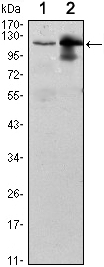UBE1L Monoclonal Antibody
- Catalog No.:YM0643
- Applications:WB;ELISA
- Reactivity:Human
- Target:
- UBE1L
- Fields:
- >>Ubiquitin mediated proteolysis;>>Parkinson disease;>>Pathways of neurodegeneration - multiple diseases
- Gene Name:
- UBA7
- Protein Name:
- Ubiquitin-like modifier-activating enzyme 7
- Human Gene Id:
- 7318
- Human Swiss Prot No:
- P41226
- Immunogen:
- Purified recombinant fragment of human UBE1L expressed in E. Coli.
- Specificity:
- UBE1L Monoclonal Antibody detects endogenous levels of UBE1L protein.
- Formulation:
- Liquid in PBS containing 50% glycerol, 0.5% BSA and 0.02% sodium azide.
- Source:
- Monoclonal, Mouse
- Dilution:
- WB 1:500 - 1:2000. ELISA: 1:10000. Not yet tested in other applications.
- Purification:
- Affinity purification
- Storage Stability:
- -15°C to -25°C/1 year(Do not lower than -25°C)
- Other Name:
- UBA7;UBE1L;UBE2;Ubiquitin-like modifier-activating enzyme 7;Ubiquitin-activating enzyme 7;D8;Ubiquitin-activating enzyme E1 homolog
- Molecular Weight(Da):
- 112kD
- References:
- 1. Cancer Res. 1992 Mar 15;52(6):1536-41
2. Proc Natl Acad Sci U S A. 1993 Jul 1;90(13):6071-5.
3. Proc Natl Acad Sci U S A. 2002 Mar 19;99(6):3806-11.
- Background:
- The modification of proteins with ubiquitin is an important cellular mechanism for targeting abnormal or short-lived proteins for degradation. Ubiquitination involves at least three classes of enzymes: ubiquitin-activating enzymes, or E1s, ubiquitin-conjugating enzymes, or E2s, and ubiquitin-protein ligases, or E3s. This gene encodes a member of the E1 ubiquitin-activating enzyme family. The encoded enzyme is a retinoid target that triggers promyelocytic leukemia (PML)/retinoic acid receptor alpha (RARalpha) degradation and apoptosis in acute promyelocytic leukemia, where it is involved in the conjugation of the ubiquitin-like interferon-stimulated gene 15 protein. [provided by RefSeq, Jul 2008],
- Function:
- function:Activates ubiquitin by first adenylating with ATP its C-terminal glycine residue and thereafter linking this residue to the side chain of a cysteine residue in E1, yielding an ubiquitin-E1 thioester and free AMP.,miscellaneous:There are two active sites within the E1 molecule, allowing it to accommodate two ubiquitin moieties at a time, with a new ubiquitin forming an adenylate intermediate as the previous one is transferred to the thiol site.,pathway:Protein modification; protein ubiquitination.,similarity:Belongs to the ubiquitin-activating E1 family.,subunit:Monomer (By similarity). Binds and is involved in the conjugation of G1P2/ISG15.,tissue specificity:Expressed in a variety of normal and tumor cell types, but is reduced in lung cancer cell lines.,
- Subcellular Location:
- nucleus,nucleoplasm,cytosol,
- Expression:
- Expressed in a variety of normal and tumor cell types, but is reduced in lung cancer cell lines.
- June 19-2018
- WESTERN IMMUNOBLOTTING PROTOCOL
- June 19-2018
- IMMUNOHISTOCHEMISTRY-PARAFFIN PROTOCOL
- June 19-2018
- IMMUNOFLUORESCENCE PROTOCOL
- September 08-2020
- FLOW-CYTOMEYRT-PROTOCOL
- May 20-2022
- Cell-Based ELISA│解您多样本WB检测之困扰
- July 13-2018
- CELL-BASED-ELISA-PROTOCOL-FOR-ACETYL-PROTEIN
- July 13-2018
- CELL-BASED-ELISA-PROTOCOL-FOR-PHOSPHO-PROTEIN
- July 13-2018
- Antibody-FAQs
- Products Images

- Western Blot analysis using UBE1L Monoclonal Antibody against Raji (1) and THP-1 (2) cell lysate.



